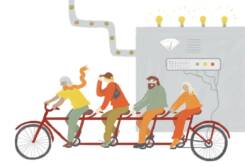Work ability and its significance
Work ability is the central prerequisite for working. People who are able to work can cope with their job duties and, at the same time, accrue their future pensions. However, in the course of working life, a situation may arise when the work ability is threatened due to illness, injury or impairment. The earnings-related pension system has the means to address such situations and to help employees maintain their ability to work.
Content of this page
Components of work ability
Work ability is based on physical, mental and social health as well as functional capacity.
For example, medicine has no uniform definition of functional ability, but it can be considered to mean a balance between one’s own abilities and goals and the environment where people live and work: it is about how a person copes with the demands of daily life. Work ability, in turn, can be defined as the ability to cope with one’s own work or the tasks of a corresponding occupation.
Work ability is also affected by a person’s skills, values, motivation and workplace conditions. In other words, a person’s work ability is the sum of many components.
Changes in work ability are natural
Many changes occur in work ability during a person’s lifetime.
For example, physical strength tends to diminish with age. On the other hand, changes in the other components of work ability, such as the development of one’s own skills and competence, may simultaneously enhance work ability. The effects of ageing are thus individual and depend on many factors, which do not necessarily impair work ability.
Work ability is also strengthened by meaningful and suitably challenging work. In contrast, if the work does not match one’s own expectations and feels forced, work ability may decline even in the absence of changes in physical performance.
Changes in work ability can also lead to disability
Changes in work ability can also lead to a situation where an individual is no longer able to perform their job to the fullest. In a situation where the ability to work has not been lost completely, the person is considered to be partially able to work. On the other hand, if the work ability is lost completely, one can speak of disability.
In general, the shift from work ability to disability does not happen overnight. The earnings-related pension system also has ways to address the threat to work ability, and to strive to prevent disability.
If a person’s illness, injury or impairment threatens to lead to disability, the person may be granted vocational rehabilitation arranged by an authorized pension provider. The goal of vocational rehabilitation is to prevent disability and help people to cope longer in working life. More information on vocational rehabilitation arranged by authorized pension providers is available on our page Vocational rehabilitation.
If the loss of work ability is inevitable, the earnings-related pension and national pension included in the social and insurance system secure the person’s livelihood by means of a disability pension. Granting a disability pension, however, is the last option. Not only the applicant’s work ability but also the possibilities and needs for rehabilitation are assessed before a disability pension is granted. This is done because work ability always means compatibility and balance between the employee’s own resources and the work. A person may therefore be able to work in one occupation but not in another one.
The assessment of work ability is described in more detail on our page Assesment of work ability.
It’s important to ensure work ability
Taking care of one’s own work ability is important for employees and self-employed persons from the perspective of livelihood both now and in the future. The earnings-related pension accrues from work, so the longer a person can continue working, the better the pension provision will be.
The earnings-related pension system also participates in the maintenance of work ability by implementing activities related to the management of the disability risk. The goal of these activities is to reduce employees’ disability risk and the risk of retiring on disability. Premature disability and disability pensions are a major cost item to the earnings-related pension system. Disability risk management measures thus have an impact on the financing and financial sustainability of the entire earnings-related pension system. Also for the individual, continuing at work is always a better financial option than retiring on disability pension.
